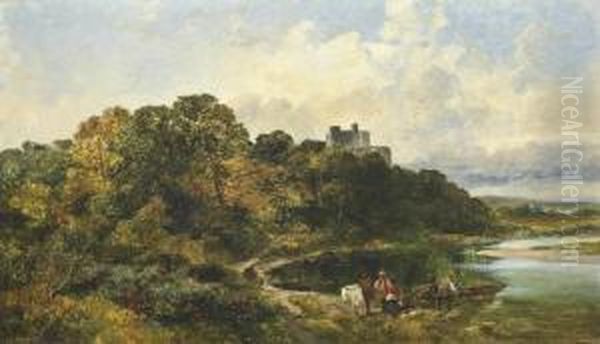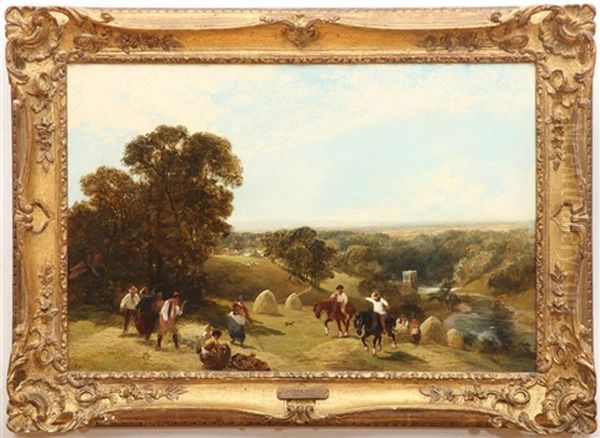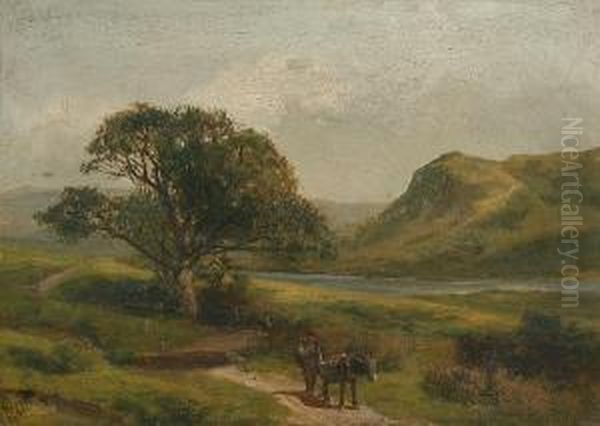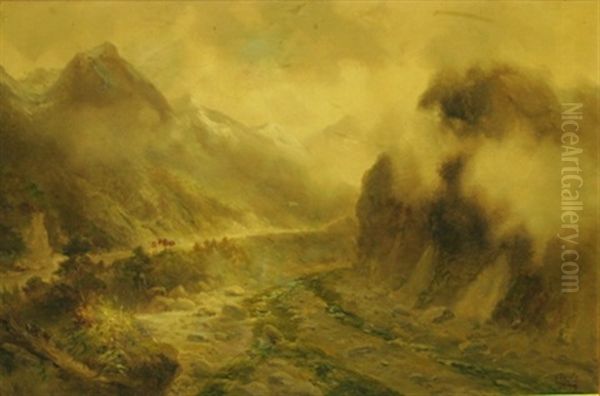The name James Peel resonates within various historical contexts, leading to potential confusion between several distinct individuals active in art, politics, and colonial ventures during the 18th, 19th, and early 20th centuries. The specific focus here is intended to be James Peel (1811-1906), identified in source materials as a British landscape painter. However, the available information often conflates him with the prominent American artist James Peale (1749-1831), the colonizer Thomas Peel and his son, the statesman Sir Robert Peel, and the Canadian painter Paul Peel. This exploration aims to synthesize the provided details, acknowledging these overlaps and contradictions while attempting to illuminate the life and work attributed to each figure, particularly the British landscape artist James Peel.
The British Landscape Painter: James Peel (1811-1906)
Based on the limited specific references, James Peel (1811-1906) was an English artist primarily known for his landscape paintings. His work is characterized as capturing fresh, natural English scenery, with a particular skill noted in the detailed and sensitive depiction of trees. This places him firmly within the rich tradition of British landscape art that flourished throughout the 19th century. His lifespan covers a period of significant evolution in this genre, from the legacy of Romantic painters like John Constable and J.M.W. Turner to the detailed naturalism favoured by the Pre-Raphaelites and the atmospheric effects explored by later Victorian artists.
One work specifically attributed to this James Peel is titled "Figures and Horses." It is described as a masterpiece conveying a sense of tranquility and expansive distance, showcasing his understanding of natural landscapes and atmospheric perspective. Such scenes were popular during the Victorian era, appealing to a growing middle-class market interested in depictions of the British countryside, often imbued with a sense of peace and stability. Artists like Myles Birket Foster also specialized in idyllic rural scenes, though Peel's specific style is noted for its focus on arboreal detail.

Despite these fragments, the source material explicitly states that direct information regarding the nationality and professional background of James Peel (1811-1906) is lacking. This scarcity contrasts sharply with the wealth of information available for other individuals bearing the Peel or Peale name, particularly the American artist James Peale, leading to frequent misattributions and conflation in biographical summaries. The challenge lies in separating the documented activities of the British landscape painter from the more extensively recorded lives of others.
The American Artist: James Peale (1749-1831)
A significant portion of the information often associated with "James Peel" actually pertains to James Peale (note the different spelling), born in Chestertown, Maryland, in 1749. He was a prominent member of the Peale family, a dynasty of American artists founded by his older brother, Charles Willson Peale. James Peale's artistic career spanned the formative years of the United States, and he became known primarily for his miniature portraits and, later in life, for his still-life paintings.
James Peale's artistic journey began under the tutelage of his brother. Initially working in various trades, including saddle making and cabinet making, he became Charles Willson Peale's assistant around 1769. His early artistic output focused heavily on miniature painting, a highly sought-after format for portraiture before the advent of photography. These small, detailed works required exceptional precision and control. He served as an officer in the Continental Army during the American Revolutionary War, rising to the rank of Captain.
Following his military service, James returned to Philadelphia and initially shared a studio with Charles Willson Peale. They reportedly reached an agreement where James would specialize in miniatures, while Charles focused on larger portraits and historical scenes. This division allowed both brothers to flourish within the burgeoning American art market. James Peale's miniatures were praised for their delicate execution and likeness, capturing the elite of post-Revolutionary society.
As his eyesight began to fail around 1810, making the intricate work of miniatures difficult, James Peale shifted his focus to painting full-size portraits and, notably, still lifes. He became one of America's first professional still-life painters, alongside his nephew Raphaelle Peale. His still-life compositions often featured fruits and vegetables arranged on tabletops, characterized by precise rendering, attention to texture, and a sense of balanced harmony. Works like "Still Life - Bitter Melons, Apples, and Vegetables" and "Still Life of Fruit on a Tabletop" exemplify this phase of his career.

James Peale's style, both in portraiture and still life, is described as exhibiting delicate color harmonies, soft outlines, and a free handling of paint, particularly evident in the rendering of fabrics and flesh tones in his portraits. He paid meticulous attention to detail, giving surfaces a distinct luster and vibrancy. His portraits, especially of male subjects, were noted for their strength and characterization. Examples include portraits like "Thomas Cumpston" and "Mary (Polly) Lawton Bringhurst."
His historical paintings, though less numerous than his portraits or still lifes, captured significant moments of the Revolution. "The Generals at Yorktown" (1781) depicted George Washington and his officers following the British surrender, while "Sir Peter Parker's Attack on Fort Moultrie" (1781) commemorated an American victory near Charleston. These works aligned with the nationalistic spirit of the era and contributed to the visual narrative of the young republic, alongside works by contemporaries like John Trumbull.
James Peale exhibited his work frequently in Philadelphia, gaining considerable appreciation. His paintings found homes in significant collections and were displayed in venues such as his brother's famous Peale Museum. More recently, institutions like the Brandywine Gallery have acquired his works, such as "Still Life of Fruit on a Tabletop" in 2004, indicating continued art historical interest. His legacy is intertwined with the Peale family's immense contribution to early American art and culture, standing alongside figures like Gilbert Stuart and John Singleton Copley in defining the artistic landscape of the Federal period.
Colonial Ventures and Political Life: Other Peels
The narrative surrounding "James Peel" is further complicated by references to figures involved in British colonial expansion and politics. One prominent figure is Thomas Peel (cousin of Sir Robert Peel, the future Prime Minister), who led a disastrous colonization scheme in Western Australia. In 1829, he arrived at Woodman Point aboard the ship Gilmore with a group of settlers, aiming to establish a large land grant settlement near the Swan River. This venture was plagued by poor planning, delays, and harsh conditions.
The source material mentions a "James Peel," described as the second son of Thomas Peel (incorrectly identified as the founder of the London police – that was Sir Robert Peel Sr.'s son, Sir Robert Peel Jr.), born in 1873 (a date inconsistent with the 1829 colonization). This James Peel is said to have accompanied his father Thomas on the Gilmore. This account seems highly confused regarding dates and parentage. Thomas Peel the colonizer did have children who accompanied him, but the specific details provided (birth year, father's identity) appear inaccurate or conflated.

This colonial narrative includes dramatic events. Settlers under Thomas Peel faced conflict with the local Noongar people over land and resources near the Canning River from 1829-1830. The source mentions a "James Peel" being appointed governor in 1831 (likely referring to Governor James Stirling, not a Peel) and shooting a Noongar leader named Dencil (historical accounts attribute this killing to a settler named James Henty or similar, not definitively Peel). The settlement ultimately struggled, with many settlers abandoning the Peel grant by 1833 due to mismanagement and hardship, leaving Thomas Peel deeply in debt.
Further confusion arises from a mention of a James Peel involved in personal controversies. In 1858, a James Peel (possibly Thomas Peel's son, Thomas Peel Jr., or another relative involved in the colony) was accused of violently assaulting a servant named Eliz. Maud and potentially attempting to murder her. The source also mentions this James Peel being accused of sexual harassment against Maud and notes the death of his wife, Julia Peel, from tuberculosis in 1856. This individual reportedly died in 1865, adding another layer of distinct identity separate from the artists or the primary colonizer.
Finally, the educational background attributed in one section – Harrow School and a Double First degree from Christ Church, Oxford – belongs unequivocally to Sir Robert Peel (1788-1850), the renowned British Prime Minister, not to any of the artists or colonists named James Peel/Peale mentioned elsewhere. This highlights the extent of the identity confusion within the source material. Sir Robert Peel's political career, including founding the Metropolitan Police Force, is entirely separate from the artistic or colonial activities discussed.
The Canadian Impressionist: Paul Peel (1860-1892)
Adding yet another dimension is the mention of Paul Peel, a celebrated Canadian painter. While sharing the surname, Paul Peel (1860-1892) belongs to a later generation and a different national context. He studied art initially in Canada, then at the Pennsylvania Academy of the Fine Arts under Thomas Eakins, and later in Paris at the École des Beaux-Arts under Jean-Léon Gérôme.
Paul Peel achieved significant international recognition during his short life. He is best known for his sentimental genre scenes, often featuring children, and his academic nudes. His style incorporated elements of Impressionism, particularly in his handling of light and color, blended with academic techniques. His most famous work, "After the Bath" (1890), won a third-class medal at the Paris Salon, a major achievement for a Canadian artist at the time.

His works were exhibited widely, including in London and Paris, and he remains a key figure in Canadian art history. Major retrospectives, such as the one held in London, Ontario, and Montreal in 1987, have cemented his reputation. Mentioning him alongside James Peel (1811-1906) or James Peale (1749-1831) serves primarily to illustrate the potential for name confusion, as their artistic styles, subjects, and historical contexts are markedly different. Paul Peel's engagement with late 19th-century European art movements contrasts with the earlier American Neoclassicism/Federal style of James Peale and the presumed Victorian landscape style of the British James Peel.
Education, Training, and Artistic Circles
The information regarding the education and training of the various James Peels/Peales is inconsistent. As noted, the prestigious education at Harrow and Oxford belongs to Sir Robert Peel, the statesman. For the British landscape painter James Peel (1811-1906), the source material explicitly states that no direct information about his education or artistic training is provided. We can only speculate that he likely trained within the established British systems, perhaps apprenticing with another artist or attending one of the London art schools, but evidence is lacking. His influences might have included earlier British landscape masters like Thomas Gainsborough or Richard Wilson, or contemporaries focused on detailed naturalism.
In contrast, the training of the American artist James Peale (1749-1831) is better documented. He learned painting primarily from his elder brother, Charles Willson Peale, working as his assistant. Through his brother, James also connected with the wider artistic community. Charles Willson Peale himself had studied in London with the influential American expatriate painter Benjamin West. This connection placed the Peale brothers within the transatlantic artistic currents of the time. James Peale, therefore, benefited from this indirect link to West's studio, a crucial training ground for many aspiring American artists like Gilbert Stuart and John Trumbull.
The source mentions James Peale's interaction with his brother Charles Willson Peale as a key professional relationship. They shared a studio and collaborated early in their careers before specializing. James Peale was thus deeply embedded in the artistic network centered around his family in Philadelphia, which included not only Charles Willson but also nephews like Raphaelle Peale (another pioneer of American still life) and Rembrandt Peale (a successful portraitist). The lack of similar information for James Peel (1811-1906) makes it difficult to place him within specific artistic circles or trace his lineage of training.
Art Historical Evaluation and Legacy
Assessing the art historical standing of James Peel (1811-1906) is hampered by the scarcity of dedicated information and the persistent confusion with James Peale. The available description praises his "fresh, natural English landscapes" and skill with trees, suggesting a competent, perhaps regionally recognized, Victorian landscape painter. Works like "Figures and Horses" point to an ability to create appealing, tranquil scenes in line with popular tastes of the era. However, the source material indicates a lack of significant academic research or widespread critical evaluation specifically focused on him. His legacy remains overshadowed by the more famous Peales.
James Peale (1749-1831), conversely, holds a secure place in American art history. He is recognized as a leading miniaturist of the Federal era and a crucial early figure in the development of American still-life painting. His work is studied alongside that of his brother Charles Willson Peale and his nephews Raphaelle and Rembrandt Peale. His contributions are acknowledged in surveys of American art, and his paintings are held by major museums. His active period (c. 1760s-1831) marks him as a foundational figure whose work reflects the artistic aspirations of the new nation.
The legacy of Thomas Peel the colonizer is one of failure and controversy in the history of Western Australia's settlement. Sir Robert Peel's legacy is immense in British political history. Paul Peel is remembered as a pioneering Canadian artist who achieved international success. Each of these figures carries historical weight in their respective fields, further complicating the task of isolating and evaluating the specific contributions of the British landscape painter James Peel (1811-1906).
Conclusion: Distinguishing the Peels and Peales
The identity of James Peel (1811-1906), the British landscape painter, remains somewhat elusive within the historical record presented. While recognized for his depictions of English scenery and particularly trees, his life and work are sparsely documented compared to the celebrated American artist James Peale (1749-1831). The latter's career as a miniaturist, portraitist, and still-life painter within the influential Peale family is well-established.
Furthermore, the narrative is clouded by references to Thomas Peel's troubled colonial venture in Australia, the associated (and likely misidentified) James Peel involved in that saga, the unrelated political giant Sir Robert Peel, and the talented Canadian artist Paul Peel. Synthesizing the available, often contradictory, information requires careful differentiation between these individuals who shared a name but occupied vastly different historical, geographical, and professional spheres. While James Peale stands as a significant figure in early American art, and Paul Peel in Canadian art, James Peel (1811-1906) emerges as a representative of the British landscape tradition whose specific contributions warrant further clarification, distinct from the complex web of Peels and Peales across history.